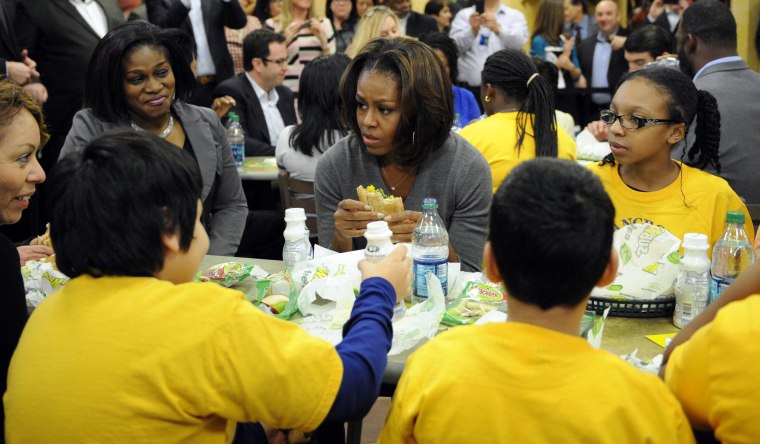Technology in classrooms may put a crimp in newly proposed rules to limit junk food marketing in schools.
The White House and the U.S. Department of Agriculture have announced new school wellness standards to offer students healthier food options. Under the guidelines, companies must phase out advertisements featuring sugary drinks and junk foods, which might appear on vending machines, cups, lunchroom menu boards and other school fixtures.
Marketing would be limited to foods that fit "Smart Snacks in School" nutrition standards set to be implemented in the 2014-15 school year.
"The idea here is simple—our classrooms should be healthy places where kids aren't bombarded with ads for junk food," first lady Michelle Obama said in a statement.
Food and beverage makers spend roughly $150 million each year marketing in schools, and federal guidelines offer schools a better framework for which ads are appropriate, said Marlene Schwartz, director for the Rudd Center for Food Policy & Obesity at Yale University. "So far everything [the food industry] has done has been through self-regulation," she said. "It's had some impact, but it's been limited."
The Grocery Manufacturers Association didn't immediately respond to requests for comment.
But junk food ads may not be out of the classroom entirely. "It's important to remember that the school environment extends online," said Matthew Wallaert, creator of Bing for Schools, which offers districts ad-free search technology. "Schools should be sensitive to the fact that many of the things that can be advertised to kids online are not necessarily the best things for kids."
Technology is increasingly a part of the classroom. In 2008, the ratio of students to Internet-connected classroom computers was nearly 3 to 1, down from almost 7 to 1 in 2000, reports the National Center for Education Statistics.
While many schools have banned use of personal gadgets in class, others now encourage it for note-taking, research and in-class assignments. About 44 percent of elementary, middle and high school students have done school work on a smartphone, according to a 2013 survey from education company Pearson. Ads may pop up in the course of those classroom Web activities, or during the social media checking and Web browsing done between classes and during lunch.
Food companies are also spending more of their marketing budgets on digital promotions, versus television ads and in-school marketing. A 2012 Federal Trade Commission study found that in 2007, food companies' overall spending on marketing to people ages 2-17 fell 19 percent from the previous year, to $1.79 billion. But over that same period, they spent 50 percent more on online, mobile and viral marketing promotions targeting that age group.
"Our research suggests certainly that digital marketing is where the big increases are," Schwartz said.
Although the Children's Online Privacy Protection Act prevents companies from collecting personal information and restricts marketing to kids under 13, many promotions are hard for children to identify as ads, said Miro Copic, a marketing lecturer at San Diego State University. There's often a game component, or they focus more on brand interaction, like voting for a new flavor.
And experts say there's little chance that food companies will cut kid-focused marketing entirely. "With snack foods, you absolutely have to get them early," Copic said. "Consumption peaks in snack foods when you're about 24. Then it starts to decline."
